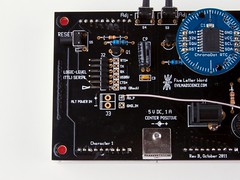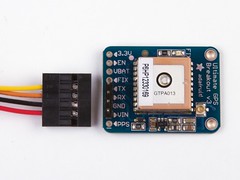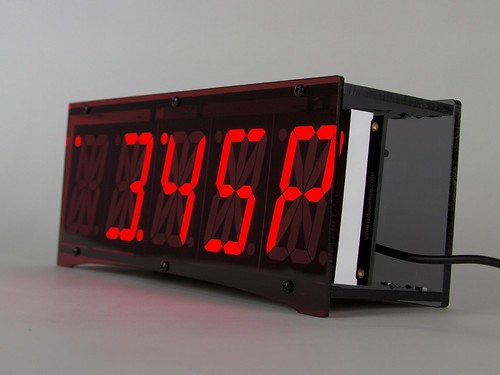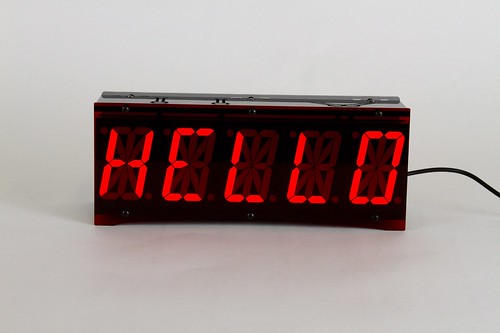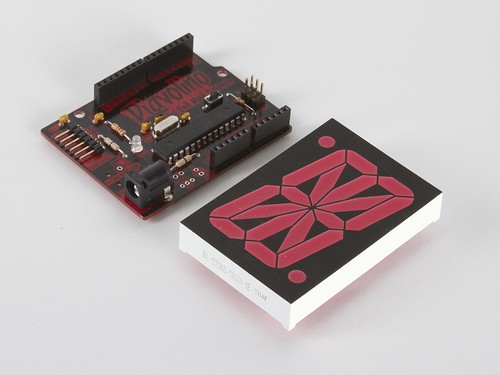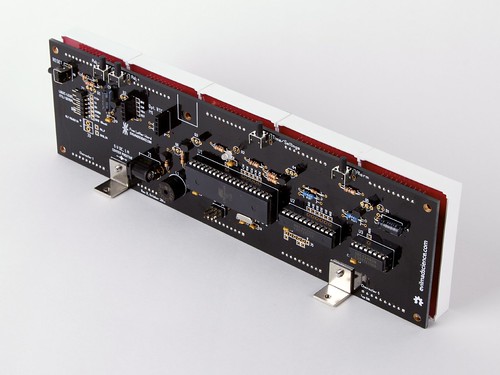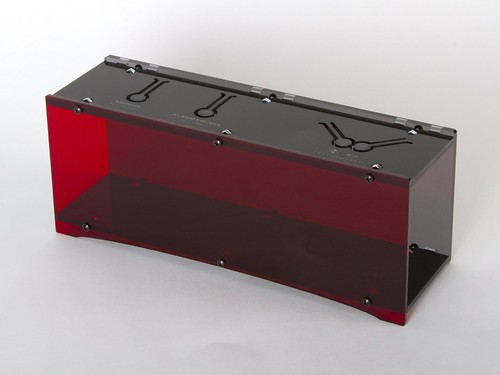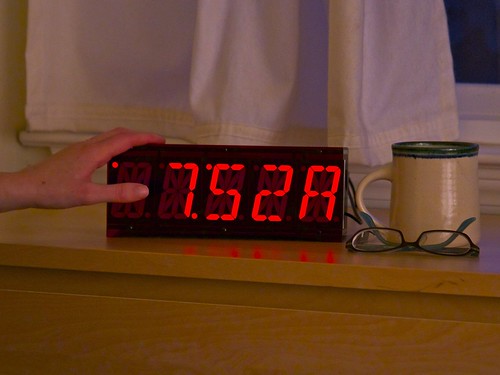Our friend Schuyler St. Leger added a vintage telephone bell to his Alpha Clock Five to make an alarm clock that could wake the dead— or at least a teenage boy who’s been watching late night TV.
Tag Archives: alpha clock five
Father’s Day Gift Guide
In anticipation of the upcoming father’s day holiday, we’ve put together a little gift guide with selections from our store. We’re also putting all of these items on sale now through June 12: just enter coupon code “VADER” in the shopping cart to receive 10% off.
First up is the Digi-Comp II, First Edition. It’s perfect for teaching the basics of binary math to kids and parents alike.
The Alpha Clock Five kit, in original Red Edition, the gleaming White Edition, or the brand-new Blue Edition, is the perfect clock for the discerning hobbyist. It’s eminently hackable and full-featured, with digits big enough to see across even the largest of garages or just next to the bed before you put your glasses on.
For someone expanding their electronic horizons, or working a ton of projects at once, our Diavolino Starter Packs, and AVR Starter Packs will keep them happily busy.
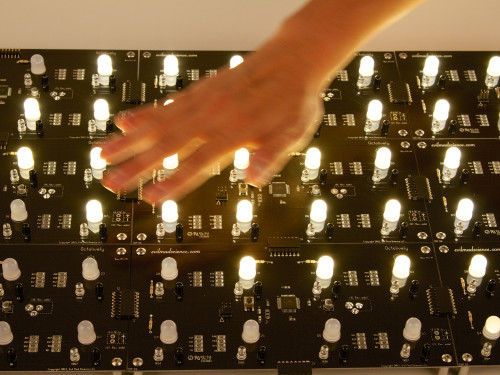
Our Octolively Modules would make an excellent addition to a furniture or remodeling project.

The Art Controller is a modern take on an old classic, perfect for someone with plenty of project ideas who just needs an occasional trigger.
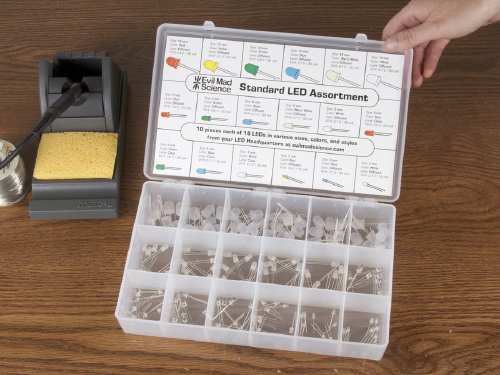
Tools are always a great gift choice, and anyone would be proud to own our ESD-Safe Screwdriver Sets. Another great workbench addition would be our Standard LED Assortment.
The Egg-Bot started out as a way for one father used to show his family how cool it could be to play with stepper motors. Both The Original Egg-Bot Kit and the Ostrich Egg-bot are on sale.
The father’s day sale runs through June 12: enter coupon code “VADER” in the shopping cart to receive 10% off these items.
Happy Father’s Day!
Alpha Clock Five: Introducing the Blue Edition!
Introducing our newest open source hardware kit: The Blue Edition of Alpha Clock Five.
Alpha Clock Five is our flagship clock kit, which thus far has been available only in a Red Edition and in a White Edition. Whichever color you happen to like, it is a full-featured, beautiful, and extraordinarily easy-to-read desk clock based around oversized 2.3″ alphanumeric LED displays. It’s designed to work equally well as a bedside alarm clock and as a computer-controlled alphanumeric data display device.
We’ve already written extensively about the core design of Alpha Clock Five. We’ve also written about the modes and features added in version 2.0 of our Arduino-compatible firmware (such as date display and daisy chained scrolling text), and about the hardware changes necessary to support the White Edition of the kit. Fortunately, the changes that we made in order to support the White Edition also allow us to support the use of blue LEDs, just as easily. And so— by popular request —we now present the Blue Edition.
Here, the Blue Edition is shown with a soda can for scale. These LEDs are big and bright, and cast a heavy glow on the soda can and tabletop. (The usual caveats about the difficulty of photographing LEDs apply: A camera cannot capture the apparent intensity of pure blue LEDs in the same way that your eyes can.)
As with the other Alpha Clock Five kits, the control buttons are cut as flexures into the top of the laser-cut acrylic case, that can bend down to contact right-angle tactile button switches at the top edge of the circuit board. The top and bottom sides of the case are made of black acrylic, and the rear panel is made from smoke-gray acrylic.
For the Blue Edition, the front face of the case is made of deep blue transparent acrylic, which helps to increase display contrast, especially in brightly lit office environments.
Without the top and back panels, you can see the electronics within: the AVR microcontroller, LED driver chips, transistors, Chronodot RTC module and the other parts that make it all work.
The Blue Edition of Alpha Clock Five is available now at the Evil Mad Scientist shop.
Doomsday Atomic Alpha Clock Five Project

From the complete overkill department, evilandy posted in the forums about his project which hooks up an Alpha Clock Five to a GPS module, a WiFi module, a WWVB Atomic radio receiver, two TXCO RTC modules and two microcontrollers because, well, we’ll let him tell you:
I wanted a clock that would display precision time and date in “all” worst case scenarios. If this clock does not show the precise time then it’s time to gather up food, water, ammunition, and the family and head for the underground bunker!
The keyswitch, fire button, and covered toggle are nice touches. Thanks for sharing your project, evilandy!
GPS time on the Alpha Clock Five
William Phelps recently wrote to us with alternative firmware for Alpha Clock Five, our oversized alphanumeric LED clock/data display kit. His firmware adds two very welcome features: Automatic daylight saving time (DST) correction, and automatic time setting via a GPS module. It works remarkably well.
Here, we’ll show you how to hook it all up and how to use it.
Continue reading GPS time on the Alpha Clock Five
Alpha Clock Five v2.0 and Alpha Clock White
Today we’re releasing a major update to Alpha Clock Five, our alphanumeric LED desk clock, alarm clock, and data display device.
Alpha Clock Five still has five remarkably bright, remarkably huge 2.3″ alphanumeric LED displays. But for version 2.0, we’ve rewritten the firmware from scratch. It’s packed with new features and it is simply a joy to use.
To name a few of those new features, Alpha Clock Five now:
- Has a built-in calendar function so that it can smoothly alternate between displaying the time and date— a neat trick for a desk clock.
- Smoothly fades between numbers (or letters) on the screen.
- Has a five letter word “art clock” mode where it displays randomly chosen five-leter words from a built-in dictionary.
- Allows you to use the second hardware serial port to daisy-chain multiple Alpha Clock Five units together for text or data display applications— for example, as we have done in the photo above.
And, here is one more thing that we’ve been cooking up for a long long time: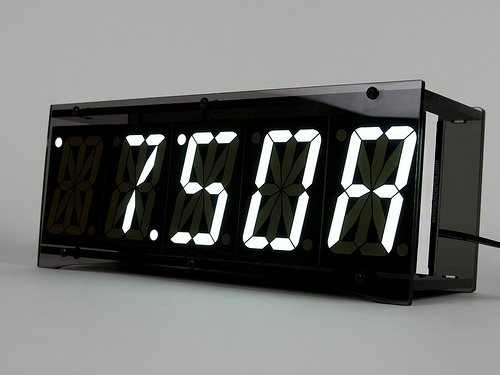

The all-new White Edition of Alpha Clock Five— with five 2.3″ alphanumeric LED displays, now in stunning white. (And, shown above with a phone for scale.)
Alpha Clock Five firmware v. 2.0 is now shipping on new Alpha Clock Five kits, and is also available as a download and free update for anyone who already has an Alpha Clock Five with the original firmware. Please see our documentation wiki for details.
Read on for more about what’s new in Alpha Clock Five v. 2.0, and about the design of the White Edition.
Continue reading Alpha Clock Five v2.0 and Alpha Clock White
Alpha Clock Five Turn Signal
Alpha Clock Five
What’s cooler than itty bitty alphanumeric LED displays? Freaking huge ultrabright alphanumeric LED displays, that’s what!
And so today we’re releasing a new kit, the Alpha Clock Five, an open-source, hacker-friendly alarm clock kit, based around an block of fiveultrabright red 2.3″ character height alphanumeric displays:
So, how big are these things?
For scale, here’s one of the displays next to a Diavolino board:
These displays are great in many ways– they’re extremely bright for one –but the downside is that they are actually a bit tricky to drive. The 10 “big” segments each have two LED elements in series, twice in parallel, while the smaller segments have two LED elements in series, but not in parallel, and the decimal points each have a single LED element. To drive each LED element at (for example) 25 mA and 2 V requires 4V, 50 mA to be provided to ten segments, 4V 25 mA to the six short segments, and 2 V at 25 mA to each decimal point. And, it’s a fair number of signals to manage as well.
To solve the problem, we designed a multiplexed driver board, with two LED driver chips at different current set points. A 16-bit constant-current LED driver is preset at 50 mA and drives the ten large segments, while a separate 8-bit constant-current LED is preset at 25 mA and drives the short segments and the decimal place. The multiplexing is in analogy with an LED matrix, where each alphanumeric character comprises one row of our matrix– which just happens to have 54 LED elements inside. One row is switched on at a time by one of five transistors. We used high-current, low-saturation-voltage PNP transistors, type 2STX2220– the low saturation voltage means that you *can* use these to switch a useful 4 V load, even when running at 5 V.
The circuit board is 9.430 X 2.736″ in size, and extra stiff at 0.094″ thick in order to support those heavy LED displays in their sockets. An ATmega644A microcontroller runs the show, and is preloaded with a bootloader so that you can program it like a Sanguinoboard, through a version of the Arduino IDE with added extensions. There’s also a magnetic buzzer so that it can be a full-on alarm clock, and a spot for a Chronodot module, for good timekeeping and battery backup.
Here’s what the front of the “brick” looks like, with the five displays socketed next to one another. There are four right-angle tactile button switches hanging off of the top edge, so that you can adjust the time, alarm time, brightness, and so forth. If you hold the two rightmost buttons for a couple of seconds, it brings you to the options menu, where you can (for example) switch between 12 and 24 hour modes:

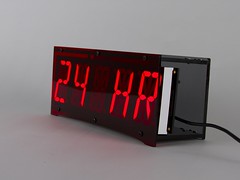
The circuit board, laden with alphanumeric displays, sits inside an acrylic case:
The front side of the case is deep red transparent acrylic (#2423 red transparent, should that come in handy), and serves to increase the contrast of the displays. The back of the case is gray transparent acrylic, and the top and bottom are black. The top surface has engraved labels for the four buttons, and four button keys cut into the acrylic. The thin beam flexes easily, contacting the right-angle switch below, when the circuit board is there.
The back of the case is transparent so that you can see the circuit board. There’s also a white LED “night light” on the circuit board that can be enabled or disabled with the top buttons, and the sides are open to provide easy access to the TTL serial interface.
Obviously there’s a lot that could be done by hooking up a nice 5-character alphanumeric data display device to your computer.
On top of everything else, Alpha Clock Five is also a full-fledged alarm clock, right down to the snooze mode— although the word “SNOOZE” didn’t quite fit on the display (it says “SNOOZ,” if you must know).
Perhaps the biggest challenge for making it “bedroom compatible” was that it needed to not just be able to be extremely bright, it also has to be able to go crazy dim– which it can do, with fourteen levels of adjustable brightness.
And it has some fantastic features as an alarm clock– for example multiple alarm tones and digits that are big enough to see even if you normally wear glasses.
And with a bit of code, it can be so much more. Soon, yours might say spell out “TRACY WAKE THE HECK UP” or use a couple of its spare I/O lines– and only make you coffee if you actually manage to get up on time.
Alpha Clock Five is available now at the Evil Mad Scientist Shop.
















